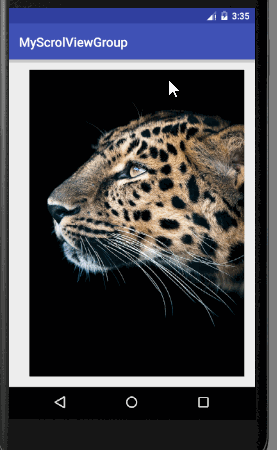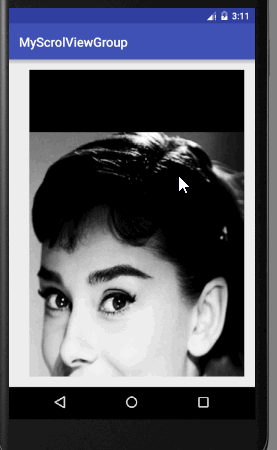最近一直在研究自定义控件,一般大致分为三种情况:自绘控件,组合控件,继承控件。接下来我们来看下继承控件。在此借鉴一位博主的文章,补充粘性的实现效果,并且加注自己的一些理解。大家也可以查看原文博客。android之自定义viewGroup仿scrollView详解 直接上代码,注释的比较详细。可以通过Log的信息来观察下滑动时候坐标的变化,加深理解。 public class MyScrollViewGroup extends ViewGroup { private Context mContext; private int mScreenHeight; private int totalHeight; private Scroller mScroller; public MyScrollViewGroup(Context context, AttributeSet attrs) { super(context, attrs); init(context); } public MyScrollViewGroup(Context context) { super(context); init(context); } private void init(Context context) { mContext = context; mScreenHeight = getScreenSize(mContext).heightPixels; mScroller = new Scroller(mContext); } /*** * 获取真实的宽高 比如200px * * @param widthMeasureSpec * @return */ public int measureRealWidth(int widthMeasureSpec) { int result = 200; int specMode = MeasureSpec.getMode(widthMeasureSpec); int realWidth = MeasureSpec.getSize(widthMeasureSpec); switch (specMode) { case MeasureSpec.EXACTLY: //MeasureSpec.EXACTLY:精确值模式: 控件的layout_width或layout_heiht指定为具体值,比如200dp,或者指定为match_parent(占据父view的大小),系统返回的是这个模式 result = realWidth; Log.d(TAG, "EXACTLY result " + result); break; case MeasureSpec.AT_MOST: // MeasureSpec.AT_MOST: 最大值模式,控件的layout_width或layout_heiht指定为wrap_content时,控件大小一般随着控件的子控件或内容的变化而变化,此时控件的尺寸不能超过父控件 result = Math.max(result, realWidth); Log.d(TAG, "AT_MOST result " + result); break; case MeasureSpec.UNSPECIFIED: // MeasureSpec.UNSPECIFIED:不指定其大小测量模式,通常在绘制定义view的时候才会使用,即多大由开发者在onDraw()的时候指定大小 result = realWidth; Log.d(TAG, "UNSPECIFIED result " + result); break; } return result; } /*** * @param widthMeasureSpec 系统测量的宽 一共是32位的 高2位代表模式 低30位表示大小 * @param heightMeasureSpec 系统测量的高 一共是32位的 高2位代表模式 低30位表示大小 */ @Override protected void onMeasure(int widthMeasureSpec, int heightMeasureSpec) { super.onMeasure(widthMeasureSpec, heightMeasureSpec); Log.d(TAG, "widthMeasureSpec " + widthMeasureSpec); Log.d(TAG, "heightMeasureSpec " + heightMeasureSpec); /***自身宽*/ int measureSelfWidth = measureRealWidth(widthMeasureSpec); int measureSelfHeight = MeasureSpec.getSize(heightMeasureSpec); Log.d(TAG, "widthMeasure " + measureSelfWidth); Log.d(TAG, "widthMode " + MeasureSpec.getMode(widthMeasureSpec)); Log.d(TAG, "heightMeasure " + MeasureSpec.getSize(heightMeasureSpec)); Log.d(TAG, "heightMode " + MeasureSpec.getMode(heightMeasureSpec)); int childCount = getChildCount(); for (int i = 0; i < childCount; i++) { View childView = getChildAt(i); measureChild(childView, widthMeasureSpec, heightMeasureSpec); } //设置viewGroup的宽高,也可以在onlayout中通过layoutParams设置 totalHeight = getScreenSize(mContext).heightPixels * childCount; setMeasuredDimension(measureSelfWidth, totalHeight); } @Override protected void onLayout(boolean changed, int l, int t, int r, int b) { Log.d(TAG, "onLayout left " + l); Log.d(TAG, "onLayout top " + t); Log.d(TAG, "onLayout right " + r); Log.d(TAG, "onLayout bottom " + b); Log.d(TAG, "onLayout heightPixels " + getScreenSize(mContext).heightPixels); int childCount = getChildCount(); for (int i = 0; i < childCount; i++) { View childView = getChildAt(i); childView.layout(l, i * mScreenHeight, r, (i + 1) * mScreenHeight); } } private float lastDownY; private float mScrollStart; private float mScrollEnd; @Override public boolean onTouchEvent(MotionEvent event) { switch (event.getAction()) { case MotionEvent.ACTION_DOWN: lastDownY = event.getY(); mScrollStart = getScrollY(); Log.d(TAG, "totalHeight = " + totalHeight); break; case MotionEvent.ACTION_MOVE: if (!mScroller.isFinished()) { mScroller.abortAnimation(); } float currentY = event.getY(); float dy; dy = lastDownY - currentY; Log.d("test", "dy = " + dy); Log.d("test", "getScrollY() = " + getScrollY()); Log.d("test", "getHeight() = " + getHeight()); Log.d("test", "mScreenHeight() = " + mScreenHeight); Log.d("test", "getHeight() - mScreenHeight = " + (getHeight() - mScreenHeight)); if (getScrollY() < 0) { dy = 0; //最顶端,超过0时,不再下拉,要是不设置这个,getScrollY一直是负数 } else if (getScrollY() > getHeight() - mScreenHeight) { dy = 0; //滑到最底端时,不再滑动,要是不设置这个,getScrollY一直是大于getHeight() - mScreenHeight的数,无法再滑动 } scrollBy(0, (int) dy); //不断的设置Y,在滑动的时候子view就会比较顺畅 lastDownY = event.getY(); break; case MotionEvent.ACTION_UP: mScrollEnd = getScrollY(); int dScrollY = (int) (mScrollEnd - mScrollStart); Log.d("test", "dScrollY = " + dScrollY); //此处实现的是根据滑动的距离来实现滚动 // if (mScrollEnd < 0) {// 最顶端:手指向下滑动,回到初始位置 // Log.d(TAG, "mScrollEnd < 0" + dScrollY); // mScroller.startScroll(0, getScrollY(), 0, -getScrollY()); // } else if (mScrollEnd > getHeight() - mScreenHeight) {//已经到最底端,手指向上滑动回到底部位置 // Log.d(TAG, "getHeight() - mScreenHeight - (int) mScrollEnd " + (getHeight() - mScreenHeight - (int) mScrollEnd)); // mScroller.startScroll(0, getScrollY(), 0, getHeight() - mScreenHeight - (int) mScrollEnd); // } //此处实现的是根据设定的距离,来实现粘性滑动的效果 if (dScrollY > 0) { //向上滑动dScrollY为正值 if (dScrollY < mScreenHeight / 3) { mScroller.startScroll(0, getScrollY(), 0, -dScrollY); } else { mScroller.startScroll(0, getScrollY(), 0, (mScreenHeight - dScrollY)); } } else { //向下滑动dScrollY为负值 if (-dScrollY < mScreenHeight / 3) { mScroller.startScroll(0, getScrollY(), 0, -dScrollY); } else { mScroller.startScroll(0, getScrollY(), 0, (-mScreenHeight - dScrollY)); } } break; } postInvalidate();// 重绘执行computeScroll() return true;//需要返回true否则down后无法执行move和up操作 } /** * Scroller只是个计算器,提供插值计算,让滚动过程具有动画属性,但它并不是UI,也不是滑动辅助UI运动,反而是单纯地为滑动提供计算 * 需要invalidate()之后才会调用,这个方法在onDraw()中调用 */ @Override public void computeScroll() { super.computeScroll(); Log.d(TAG, "mScroller.getCurrY() " + mScroller.getCurrY()); if (mScroller.computeScrollOffset()) {//是否已经滚动完成 scrollTo(0, mScroller.getCurrY());//获取当前值,startScroll()初始化后,调用就能获取区间值 postInvalidate(); } } /** * 获取屏幕大小,这个可以用一个常量不用每次都获取 * * @param context * @return */ public static DisplayMetrics getScreenSize(Context context) { DisplayMetrics metrics = new DisplayMetrics(); WindowManager wm = (WindowManager) context.getSystemService(Context.WINDOW_SERVICE); wm.getDefaultDisplay().getMetrics(metrics); return metrics; } } 下面附上两种运行效果,比较下不同之处。

